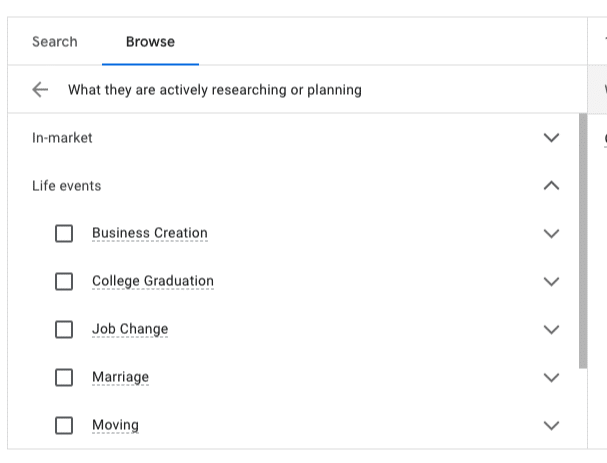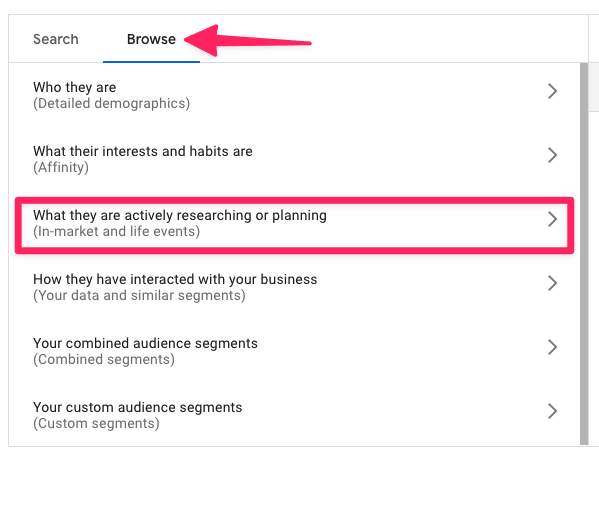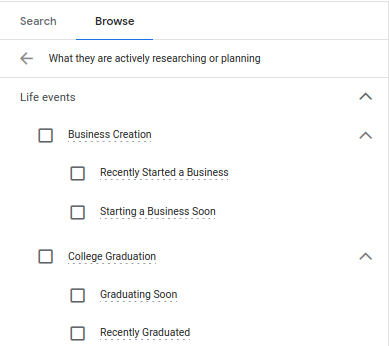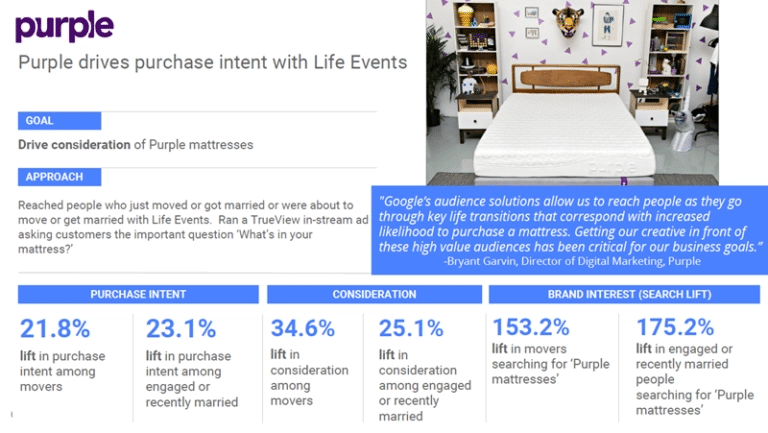Marketers can choose one of many different segments in Google Ads (In-Market, Affinity, Remarketing) to reach consumers who are most likely to make a purchase.
Sometimes, however, targeting users who are experiencing major life events, like graduating, getting married, opening a new business, retiring, and so on, can be an even more effective strategy to increase conversions, which brings us to life events targeting.
It’s yet another segment in Google Ads, but it can be easily overlooked because it’s not available for all campaigns. Moreover, since these life occasions are rare, they aren’t included in most marketing plans.
To right this wrong, we’ll introduce you to Life events segments in Google Ads: what they are, what life events targeting options are available, and how to use them in campaigns.
Table of Contents
What is Life Events Targeting in Google Ads?
Life events in Google Ads is an audience targeting option that allows you to target users as they go through life milestones.

The focus is not on a single day when users experience a life-changing event, but rather on the process of transition between two points in life (like marriage, retirement, and such).
As mentioned earlier, big life events are rare, but they are usually connected with:
- big item purchase (e.g. a house, an engagement ring), or
- a burst of purchasing activity within a short period of time (for example, when moving to a new city, planning a wedding, or starting a new job).
Let’s see how the Life events segment compares to other Google Ads segments.
The segment of users who make a big item purchase is smaller relative to an audience you can target with the Affinity segment. In other words, a segment of “users who bought a new house” is smaller than a segment of “users who like to throw backyard parties.”
On the other hand, life events segments are bigger than In-Market segments. The number of users who need a dentist in a city is limited (In-Market), but if these users are segment members of Life events “moved to a new city,” they need a lot more than just a dentist (coffee shop, school, car mechanic, beauty parlor, gym, etc.).
Demographics-based targeting can help optimize your campaign, but it doesn’t qualify users who are ready to take action. Life events targeting, on the other hand, allows you to reach users who are propelled to take purchasing action.
For example, when moving, consumers need to make a decision about hiring a moving company (either yes or no), and their age, gender, and income level don’t play as big a role in conversion as the fact they are experiencing a life milestone event (e.g. moving). Let’s see what they are.
Which Life Event Targeting Options Are Available in Google Ads?
To set up a Life event audience, select Edit Audience segment (in Audiences). You can choose the following life events:
- College Graduation
- Marriage
- Moving
- Purchasing a new home
- Business creation
- Job change
- Retirement

Each of these options has two subcategories to further specify whether you like to target users before or after the life event (for instance, Recently started a business and Starting a business soon).
This is a very useful option for targeting customers more precisely. For example, if you sell engagement rings, you want to reach people before they get married.

How Does Google Choose Users for Your Life Event Segment?
In Google Ads, Life events are found under the label “what they are actively researching or planning,” bundled together with In-Market audiences.
So, the approach to interpreting user data is similar to that for In-Market audiences: Google uses signals from users’ recent search history to populate your Life event segment.
Which Campaign Types Can Use the Life Event Segment
Unfortunately, Life events are available only for Display, and YouTube campaigns. You can select it on an Ad group level, but not on a campaign level.
When you try to set up Life events in Google Ads, first check the campaign type and ad level, otherwise you won’t find the life events targeting option in Edit Audience segment.
Life Events Targeting: Case Study
Given all that we discussed so far, you might think that life event segments aren’t really useful to the general marketer (or business).
However, this targeting option can be applied to audiences who don’t seem to have much to do with life events, at least not at first glance.
Let’s explain this with an example.
Purple sells mattresses. The launch of the company was financed through crowdfunding, which means the pressure to perform (and to provide positive cash flow) was much stronger than in companies backed by venture capital.
Their marketing had to be sharp and cost-effective for all of this to succeed, so they targeted “recent movers” and “newly married” consumers.
This is when Purple witnessed a lift in purchase intent. Brand search lift increased by 175% for a segment of newly married users.

They also ran a YouTube remarketing campaign targeting video viewers, and the increase in brand searches was 30X. This was at a time when they didn’t invest in any other marketing channel, so the results from that test are reliable.
While the increase of 175% for brand searches following life events targeting is a fine result, the 30X fold increase from the YouTube campaign is even better.
Life Events Are Great for Exclusion Lists
Life events targeting can help you save on ad spend by excluding impressions that don’t bring conversions from the campaign.
For example, if you are a moving company, there is no point in targeting users who have already completed their move to a new city. Similarly, if you are a wedding planner, you can exclude those who have already celebrated their marriage.
No other segment can allow you this type of prospect qualification at such an early stage of the selling process, so use it when applicable to increase return on ad spend (ROAS).
The Importance of Ad Creative Relevance
While Google can inform you which users are going through a big transformation, it cannot convert them for you. If you want to see an increase in conversions from life event targeting, don’t just focus on “who” you target, but also on “how” you target them.
We are talking about significant (sometimes once in a lifetime) transitions here, and the people who’ll see your ads are probably experiencing an emotional overload.
We are talking about significant (sometimes once-in-a-lifetime) transitions here, and the people who will see your ads are likely experiencing an emotional overload.
Think about college graduates entering adulthood, newlyweds starting their lives together, entrepreneurs launching a new business, or retirees leaving the workforce behind.
If your ad creative provides guidance and a steady hand during this emotional period, you will earn the customers’ trust and get more conversions.
Whether you choose “I’ve got your back” ad messaging or something else, consider the emotions your audience is feeling, as this can make the difference in getting them to click and convert.
